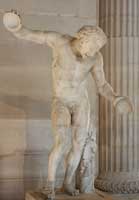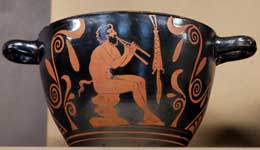.
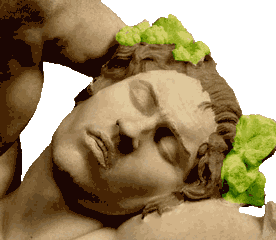
Sleeping Satyr, Munich Glyptothek, c. 220 BC
Satyrs (Satyri) in Greek mythology are half-man half-beast nature spirits that haunted the woods and mountains, companions of Pan and Dionysus. Although they are not mentioned in Homer, in a fragment of Hesiod they are called brothers of the mountain nymphs and Kuretes, and an idle and worthless race. They are strongly connected with the cult of Dionysus. Satyrs are male followers, the female followers of Dionysus are maenads.
Satyrs bear on their foreheads small bony protuberances that in a goat would grow into horns. On Attic painted vases, satyrs are strongly built with flat noses, large pointed ears, long curled (archaic?) hair, full beards, and horses' tails or goats' tails. Sometimes they have teat-like protuberances (pherea) on the neck.

Maenad and Satyr dancing with the infant Dionysus, Terra cotta Relief, British Museum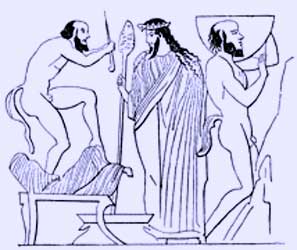
Wine Production by Satyrs
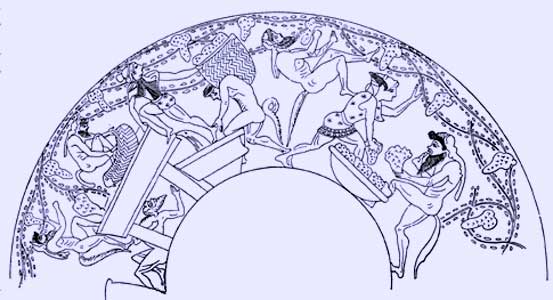
Wine Production by Silenoi and Maenads

They were a roguish but faint-hearted folk: subversive and dangerous, but shy and cowardly. As Dionysiac creatures they are lovers of wine and women, roaming to the music of pipes (auloi) and cymbals, castanets and bagpipes, dancing with the nymphs or pursuing them, and striking terror into men. They tended to engage in revelry with Dionysus and play only minor roles in myths and legends. They had a special form of dance called Sikinnis. They are instinctively ready for every physical pleasure. Wreaths of vine or ivy circle their heads. They are naked, with erect phalluses ('ithyphallic'), but drape themselves with spotted panther skins, goatskins or fawn skins, like Dionysus.
Unlike immortal creatures, the satyrs do grow old. On painted vases and in other Greek art, satyrs are represented in the three stages of a man's life. Mature satyrs are bearded, and they are shown as balding, a humiliating and unbecoming disfigurement in Greek culture. The older ones are commonly sileni, who may be distilled to a single personification of satyrlike dotage, drunken Silenus, the tutor of Dionysus.
Satyrs are not immortal, for satyrs were killed in the mythical Indian war campaign of Dionysus. And Nonnius notes that Marsyas could hardly have survived being flayed by Apollo.
They are often represented with a winecup in hand, and satyrs appear often in the decoration of winecups. Satyrs often carry the thyrsus, the rod of Dionysus tipped with a fircone.
They are depicted in a number of ways, the most common being that of the upper half of a man and the lower half of a goat, sometimes possessing horns. They were less often depicted with the lower halves of horses. In either form, however, they possessed a long thick tail and constantly erect penis. As time progressed they were depicted as 'more human' with less animalistic characteristics, until only the tail remained to show that they were satyrs.

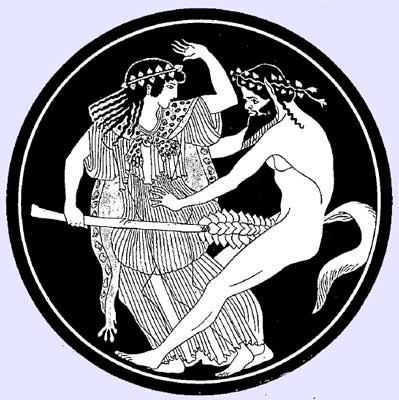
A Maenad uses the Thyrsus against a Satyr, Euphronios Painter, Berlin Museum
In earlier Greek art they appear as old and ugly, but in later art, especially in works of the Attic school, this savage character is softened into a more youthful and graceful aspect. There is a famous statue supposed to be a copy of a work of Praxiteles, representing a graceful satyr leaning against a tree with a flute in his hand. In Attica there was a species of drama known as the Satyric; it parodied the legends of gods and heroes, and the chorus was composed of satyrs. Euripides's play of the Cyclopi is the only extant example of this kind of drama.
The provocative sleeping Satyr
The older satyrs were called Sileni, the younger Satyrisci. By the Roman poets they were often confounded with the Fauns. The symbol of the shy and timid satyr was the hare. In some districts of modern Greece the spirits known as Calicantsars offer points of resemblance to the ancient satyrs; they have goats' ears and the feet of asses or goats, are covered with hair, and love women and the dance. The herdsmen of Parnassus believe in a demon of the mountain who is lord of hares and goats.
In the Authorized Version of Isa. Xiii. 25, xxxiv. 14 the word "satyr" is used to render the Hebrew sh'lrlm, "hairy ones." A kind of demon or supernatural being known to Hebrew folk-lore as inhabiting waste places is meant; a practice of sacrificing to the sh'irlm is alluded to in Lev. xvii. ~ hii where E. V. has "devils." They correspond to the "shaggy demon of the mountain-pass" (azabb al-akaba) of old Arab legend.

In the Athenian 'satyr plays,' (q.v.) 5th century BC, a chorus of satyrs and sileni commented on the action. This 'satyric drama' burlesqued the serious events of the mythic past with lewd pantomime and subversive mockery. One complete satyr play from the 5th century BC survives. It is the Cyclops of Euripides. A papyrus bearing a long fragment of a satyr play by Sophocles, given the title 'Tracking Satyrs' (Ichneutae), was found at Oxyrhynchus in Egypt, 1907.
Roman satyrs were confounded in the popular and poetic imagination with Latin spirits of woodland, the Fauns. Satyrs might also be associated with the attendants of the rustic spirit Pan, called the Panes. Roman satyrs were reimagined as goatlike from the haunches to the hooves. Roman satyrs were often pictured with larger horns, even ram's horns. Christian mythology demonized all pagan nature spirits such as satyrs, by associating them with demons and devils, though in fairness they do resemble the Jewish goat-man demon Azazel to whom the scapegoats were sent.
Roman satire (q.v.) is a literary form, a poetic essay that was a vehicle for biting, subversive social and personal criticism. Though Roman satire is sometimes thoughtlessly linked to the Greek satyr plays, satire's only connection to the satyric drama is through the subversive nature of the satyrs themselves, as forces in opposition to urbanity, decorum, and civilization itself.
|
Dancing Faun (A roman version of the Satyr) probably a scene from the sikkinis dance |
|
|
|
|
|
|
|
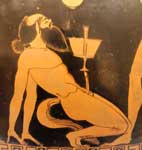
|
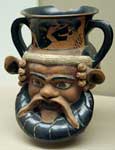
|

|
|

|
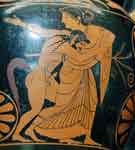
|
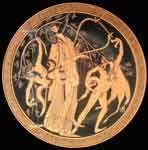
|
Hermes and the Satyr Oreimachos, Berlin Painter c. 490 BC |

|

|


Satyr and Hermaphrodit, "Erotic Dresden Symplegma", Roman Copy of a Hellenistic sculpture : 150/140 BC.

Venus and Satyr, Sebastiano Ricci
Satyr and Nymph Coins from Thasos
References
Harry Thurston Peck Harpers Dictionary of Classical Antiquities, 1898: 'Faunus', 'Pan', 'Silenus'.
See also : Greek Mythology. Paintings, Drawings
| Ancient Greece
Science, Technology , Medicine , Warfare, , Biographies , Life , Cities/Places/Maps , Arts , Literature , Philosophy ,Olympics, Mythology , History , Images Medieval Greece / Byzantine Empire Science, Technology, Arts, , Warfare , Literature, Biographies, Icons, History Modern Greece Cities, Islands, Regions, Fauna/Flora ,Biographies , History , Warfare, Science/Technology, Literature, Music , Arts , Film/Actors , Sport , Fashion --- |
Retrieved from "http://en.wikipedia.org"
All text is available under the terms of the GNU Free Documentation License


